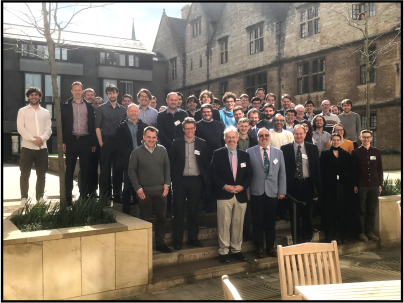The OxCHEDS Annual Meeting was held on the 20-21 March 2023 at Trinity College Oxford, attracting a record 54 registrants in approximately equal numbers from Oxford and AWE.

The return to the traditional venue of Trinity was welcome, with the meeting held in the newly constructed Levine Building (replacing the Danson Room in which the meeting had been held in previous years). Last year’s very successful meeting was kindly hosted by Gianluca Gregori at Lady Margaret Hall while the conference facilities at Trinity College were still under construction.
The meeting was opened by the OxCHEDS Directors, Justin Wark and Colin Danson, who welcomed everyone to the new conference facilities and hoped that the meeting would be as productive as in previous years. The meeting was also a celebration of the 10th anniversary of OxCHEDS itself, which was founded in May 2013.
The meeting featured a range of talks from students, academics, and AWE scientists. The meeting agenda allowed plenty of time for discussions, a vital requirement for collaboration, when these opportunities have been so difficult over recent years.
The meeting was divided into five separate sessions reflecting the broad range of collaborations between Oxford Physics and AWE:
- Inertial confinement fusion science and warm dense matter experiments
- Laser-plasma interactions and instabilities
- Modelling and machine learning
- Electronic structure and dynamics
- Phase transitions and dynamic compression

It is unfair to single out individual talks as they were all of such a high standard, but it is also important to give a feel of the meeting’s varied content. Colin Danson delivered an opening talk on the biggest development in high-energy-density-science in the last decade entitled ‘What happens after NIF ignites?’, highlighting networking efforts in both Europe and the USA. Jack Halliday, Imperial College London (soon to join Oxford) presented ‘Experiments with radiatively driven plasmas on MAGPIE’. There was also a very entertaining and thought-provoking talk from Sam Vinko comparing the possible uptake of system-wide machine learning to how industrial electrification took over 20 years to be effectively implemented in the late 19th century.
Oxford DPhil researchers invariably play an integral role in the OxCHEDS Meeting, and they gave some excellent presentations this year including: Charles Arrowsmith with ‘A platform to investigate collisionless beam-plasma instabilities at CERN’; Domenic Peake giving his first ever talk ‘Using molecular dynamics to characterise the vaporisation of an x-ray heated metal near its critical temperature’; and Pontus Svensson with ‘Development of a new quantum mechanical MD framework’.

Talks from AWE staff included an excellent and comprehensive presentation from Geoffrey Cox giving an overview of the AWE equation-of-state programme; David Hoarty giving an update on ‘Radiation burn through to infer iron opacity at solar conditions’; and Ben Thorington-Jones with ‘Heated reverse Taylor cylinder experiments for strength and damage model validation’.
Justin Wark, OxCHEDS Director, said after the meeting: ‘As always it was a great pleasure to host our AWE Colleagues for our annual OxCHEDS meeting. It is hard to believe that our Centre has now been running for nearly a decade, and the quality of the talks and discussions shows that this collaboration goes from strength to strength. The field as a whole continues to evolve: with the recent announcement of ignition on the NIF and the rise of machine learning providing further evidence of the importance and relevance of high energy density science both in academic and applied contexts.’
The meeting and venue were a great success with superb hospitality, and all who attended are looking forward to greater collaboration over the coming year. The next meeting is already pencilled into the calendar for March 2024.

